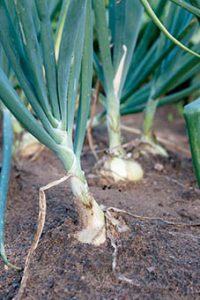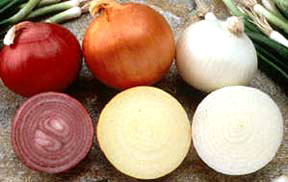Growing Onions
By Bryan Kiser, Fairfax Master Gardener
 Onions (Allium cepa) are relatively easy to grow. Basic requirements for good growth include cool weather, a sunny location and rich moist, well-drained soil with plenty of organic matter. The soil pH should be between 6.0 and 7.0, with the optimal pH at 6.5. Onions are heavy feeders, so Virginia Cooperative Extension (VCE) recommends 4 to 5 pounds of 10-10-10 fertilizer per 100 square feet before planting. Side dress with 3 tablespoons of 33-0-0 fertilizer per 10-foot row when bulbs begin to develop.
Onions (Allium cepa) are relatively easy to grow. Basic requirements for good growth include cool weather, a sunny location and rich moist, well-drained soil with plenty of organic matter. The soil pH should be between 6.0 and 7.0, with the optimal pH at 6.5. Onions are heavy feeders, so Virginia Cooperative Extension (VCE) recommends 4 to 5 pounds of 10-10-10 fertilizer per 100 square feet before planting. Side dress with 3 tablespoons of 33-0-0 fertilizer per 10-foot row when bulbs begin to develop.
Onions can be planted by direct sowing seeds, plants and sets (bulbs). VCE recommends sets for bulb onions and plants for green or bunching onions. I prefer plants for bulb production and start my seeds about six to eight weeks before I want to transplant them. Onion seedlings do not tolerate weed pressure, so I cultivate or remove the weeds by hand or with a hoe. I do this often but shallowly because onion roots are near the surface. Onions require at least 1 inch of water weekly, which is especially crucial during bulb development.
Onions are virtually pest and disease free. The most significant pests include onion maggots, aphids and thrips. Common diseases in Virginia are bacterial soft rot and fungal diseases. Root maggots, aphids and thrips can be treated organically with neem oil or pyrethrin, or chemically with Malathion. Treat bacterial soft rot with copper, and fungal diseases, such as botrytus leaf blight, downy mildew or purple blotch, with the fungicides chlorothalonil or maneb at the first sign of the diseases. Pesticide users are required by law to follow the label on the pesticide container.
Probably the most important factor for successfully growing onions that overwinter in the garden in Virginia is proper variety selection. Onions are photoperiodic, meaning that bulbing is initiated when the daylight length reaches the number of hours critical for that variety, and temperatures are between 60 F and 70 F. The warmer the temperature, the more rapid the development. Optimal air temperatures for rapid bulb development are 75 F to 85 F.
 Onion varieties are often described as northern / long day, southern / short day and intermediate or day neutral. Long day onions require 14 to 16 hours of daylight, day neutral 12 to 14 hours and short day 10 to 12 hours. Our longest day is 14 hours 46 minutes. Most long day varieties require 15 to 16 hours to bulb, so they are difficult to grow in the Piedmont area. We have 10 to 12 hours of daylight before February, but the temps are too low for short day onions to begin bulbing. One recommendation to overcome this is to plant short day onions in the fall and allow them to grow over the winter in the garden. Then there is enough vegetative growth where they will be ready and when temps increase enough to bulb. VCE recommends the day neutral variety for the Piedmont area but there are not many varieties, and they do better for spring plantings.
Onion varieties are often described as northern / long day, southern / short day and intermediate or day neutral. Long day onions require 14 to 16 hours of daylight, day neutral 12 to 14 hours and short day 10 to 12 hours. Our longest day is 14 hours 46 minutes. Most long day varieties require 15 to 16 hours to bulb, so they are difficult to grow in the Piedmont area. We have 10 to 12 hours of daylight before February, but the temps are too low for short day onions to begin bulbing. One recommendation to overcome this is to plant short day onions in the fall and allow them to grow over the winter in the garden. Then there is enough vegetative growth where they will be ready and when temps increase enough to bulb. VCE recommends the day neutral variety for the Piedmont area but there are not many varieties, and they do better for spring plantings.
I do a spring planting of intermediate onions, both red and yellow. However, they do not turn out as well as the long day ones and do not grow as big. I have had luck with fall planting a long-day variety such as Bridger that requires 14-hour days. I start my seeds the first week of August, so my transplants are ready by the 3rd week in Sept. This allows enough vegetative growth before we have hard freezes. I tried Walla Walla last fall, and they are doing well going into spring this year. I have not tried overwintering the short-day onions but plan to this fall.
References
• Onions, Garlic and Shallots, Diane Relf and Alan McDaniel, Virginia Cooperative Extension
Publication 426-411
• Onions:Organic Production in Virginia, Pam Dawling, Mark Schonbeck and Charlie Maloney,
VA Association for Biological Farming
• Virginia Pest Management Guide, Chapter 2: Home Vegetables, Tables 2.2 and 2.4.